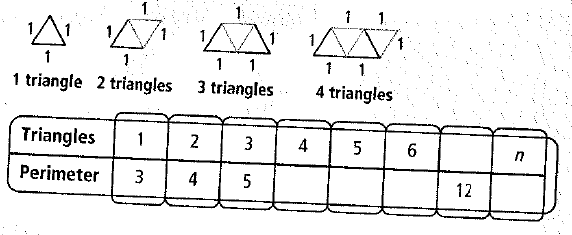
Concept explainers
For each diagram, find the relationship between the number of shapes and the perimeter of the figure they form. Represent this relationship using a table, words, an equation, and a graph.

To find : The perimeter when the triangles are 4,5 and 6. Then we need to find the number of triangles when perimeter is 12. And we need to find the rule.
Answer to Problem 1P

Explanation of Solution
Given information: We are given with number of triangles and it’s perimeters as (1,3), (2,4),(3,5),….
Calculation:
If we see the y values , they are increasing by 1 when x values are increasing by 1.
So, according to this concept, when triangles =4, perimeter=6
When triangles =5, perimeter=7
When triangles =6, perimeter=8.
Now, use the same rule to find number of triangles when perimeter is 12.
| Number of triangles | Perimeter |
| 7 | 9 |
| 8 | 10 |
| 9 | 11 |
| 10 | 12 |
Now, let’s find the rule by finding the slope and y intercept.
Take (1,3) and (2,4)
Slope
Plug in this value for ‘m’
We get y=1x+b
Use one of the points to get value for ‘b’
3=1(1) + b
3=1+ b
Subtract both sides 1
b =2
So, rule is y=x +2
Here we need to use ‘ n’ instead of x .
So, rule is n +2
Chapter 4 Solutions
ALGEBRA 1 W/CALCCHAT+CALCVIEW:STUD.ED.
Additional Math Textbook Solutions
A Problem Solving Approach To Mathematics For Elementary School Teachers (13th Edition)
Calculus: Early Transcendentals (2nd Edition)
A First Course in Probability (10th Edition)
University Calculus: Early Transcendentals (4th Edition)
Elementary Statistics: Picturing the World (7th Edition)
Elementary Statistics (13th Edition)
- Graph without using the calculator y-1 = | x+4 |arrow_forward9:43 AS く Akbar © Printed in the United States 15) Scale: 1 cmal unit on both axes .ill 64% The graph above shows a straight line QT intersecting the y-axis at T. i State the co-ordinates of T. ii Calculate the gradient of QT 16) iii Determine the equation of QT. A (-1, 9) ||| i L Г (5 marks)arrow_forwardPls help.arrow_forward
- Solve the system of equation for y using Cramer's rule. Hint: The determinant of the coefficient matrix is -23. - 5x + y − z = −7 2x-y-2z = 6 3x+2z-7arrow_forwarderic pez Xte in z= Therefore, we have (x, y, z)=(3.0000, 83.6.1 Exercise Gauss-Seidel iteration with Start with (x, y, z) = (0, 0, 0). Use the convergent Jacobi i Tol=10 to solve the following systems: 1. 5x-y+z = 10 2x-8y-z=11 -x+y+4z=3 iteration (x Assi 2 Assi 3. 4. x-5y-z=-8 4x-y- z=13 2x - y-6z=-2 4x y + z = 7 4x-8y + z = -21 -2x+ y +5z = 15 4x + y - z=13 2x - y-6z=-2 x-5y- z=-8 realme Shot on realme C30 2025.01.31 22:35 farrow_forwardUse Pascal's triangle to expand the binomial (6m+2)^2arrow_forward
 Algebra and Trigonometry (6th Edition)AlgebraISBN:9780134463216Author:Robert F. BlitzerPublisher:PEARSON
Algebra and Trigonometry (6th Edition)AlgebraISBN:9780134463216Author:Robert F. BlitzerPublisher:PEARSON Contemporary Abstract AlgebraAlgebraISBN:9781305657960Author:Joseph GallianPublisher:Cengage Learning
Contemporary Abstract AlgebraAlgebraISBN:9781305657960Author:Joseph GallianPublisher:Cengage Learning Linear Algebra: A Modern IntroductionAlgebraISBN:9781285463247Author:David PoolePublisher:Cengage Learning
Linear Algebra: A Modern IntroductionAlgebraISBN:9781285463247Author:David PoolePublisher:Cengage Learning Algebra And Trigonometry (11th Edition)AlgebraISBN:9780135163078Author:Michael SullivanPublisher:PEARSON
Algebra And Trigonometry (11th Edition)AlgebraISBN:9780135163078Author:Michael SullivanPublisher:PEARSON Introduction to Linear Algebra, Fifth EditionAlgebraISBN:9780980232776Author:Gilbert StrangPublisher:Wellesley-Cambridge Press
Introduction to Linear Algebra, Fifth EditionAlgebraISBN:9780980232776Author:Gilbert StrangPublisher:Wellesley-Cambridge Press College Algebra (Collegiate Math)AlgebraISBN:9780077836344Author:Julie Miller, Donna GerkenPublisher:McGraw-Hill Education
College Algebra (Collegiate Math)AlgebraISBN:9780077836344Author:Julie Miller, Donna GerkenPublisher:McGraw-Hill Education





